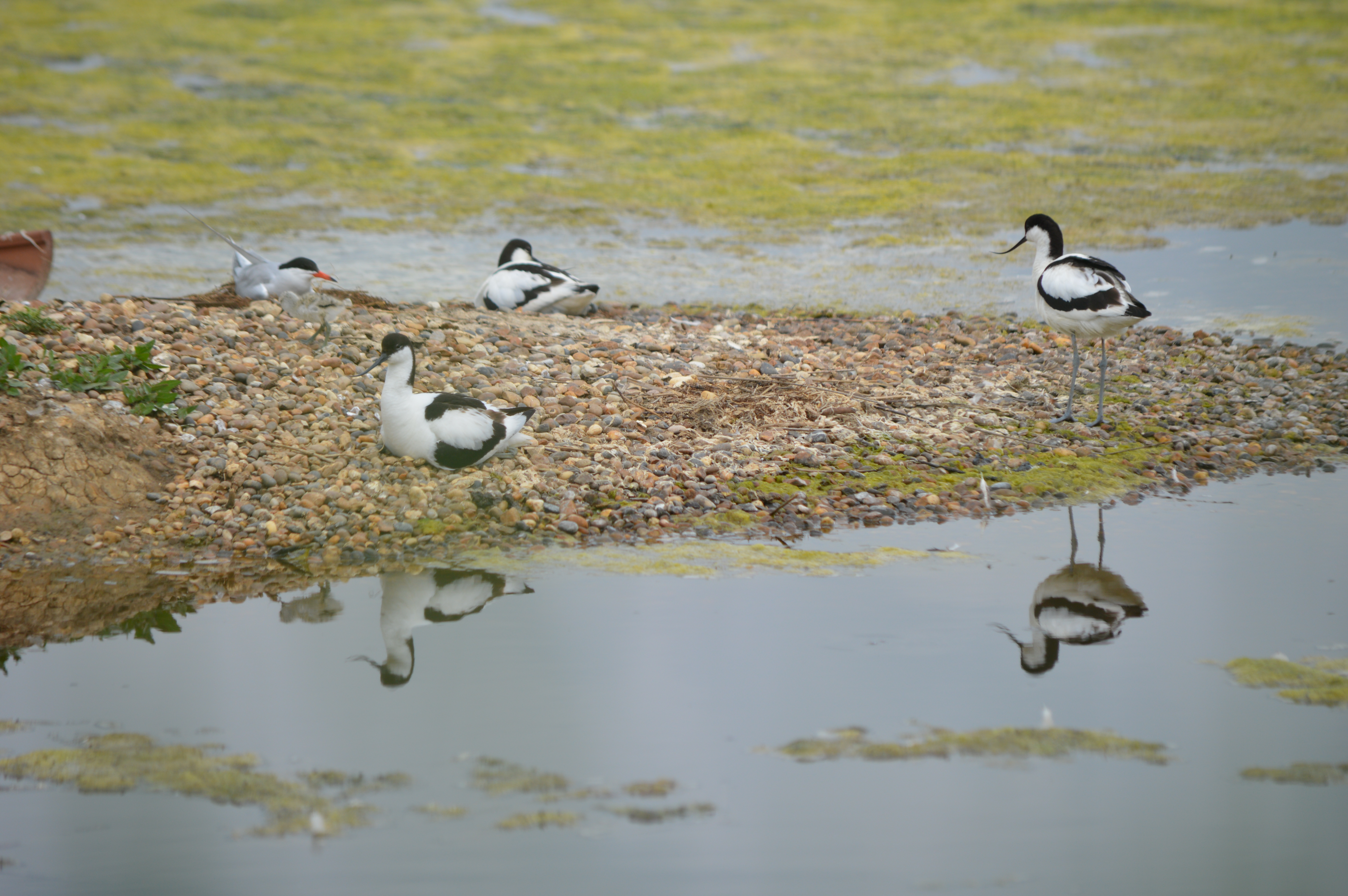|
Danish Camp
Danish Camp is an Iron Age fortified settlement in Shoeburyness in Essex. It is a Scheduled Monument under the Ancient Monuments and Archaeological Areas Act 1979, list number 1017206. The site is in the Gunners Park and Shoebury Ranges nature reserve, which is managed by the Essex Wildlife Trust. This site is classed by Natural England as a 'slight univallate hillfort'. There are two sections remaining of the defensive banks of the settlement. The surviving part of the north-western bank is around 80 metres long, and it has an average height of 2 metres and width of 11 metres. The southern bank is slightly lower. There was an external ditch, which is now largely filled. Pottery vessels have been found dating to the Middle Iron Age, around 400 to 200 years BC, together with four round houses and many post holes and pits. There is some evidence of earlier Mesolithic and Bronze Age occupation, but as this extends beyond the site it is thought to represent general utilisation of the a ... [...More Info...] [...Related Items...] OR: [Wikipedia] [Google] [Baidu] |
Danish Camp 2
Danish may refer to: * Something of, from, or related to the country of Denmark People * A national or citizen of Denmark, also called a "Dane," see Demographics of Denmark * Culture of Denmark * Danish people or Danes, people with a Danish ancestral or ethnic identity * A member of the Danes, a Germanic tribe * Danish (name), a male given name and surname Language * Danish language, a North Germanic language used mostly in Denmark and Northern Germany * Danish tongue or Old Norse, the parent language of all North Germanic languages Food * Danish cuisine * Danish pastry, often simply called a "Danish" See also * Dane (other) * * Gdańsk * List of Danes * Languages of Denmark The Kingdom of Denmark has only one official language, Danish, the national language of the Danish people, but there are several minority languages spoken, namely Faroese, German, and Greenlandic. A large majority (about 86%) of Danes also s ... {{disambiguation Language a ... [...More Info...] [...Related Items...] OR: [Wikipedia] [Google] [Baidu] |
Iron Age
The Iron Age is the final epoch of the three-age division of the prehistory and protohistory of humanity. It was preceded by the Stone Age (Paleolithic, Mesolithic, Neolithic) and the Bronze Age (Chalcolithic). The concept has been mostly applied to Iron Age Europe and the Ancient Near East, but also, by analogy, to other parts of the Old World. The duration of the Iron Age varies depending on the region under consideration. It is defined by archaeological convention. The "Iron Age" begins locally when the production of iron or steel has advanced to the point where iron tools and weapons replace their bronze equivalents in common use. In the Ancient Near East, this transition took place in the wake of the Bronze Age collapse, in the 12th century BC. The technology soon spread throughout the Mediterranean Basin region and to South Asia (Iron Age in India) between the 12th and 11th century BC. Its further spread to Central Asia, Eastern Europe, and Central Europe is somewhat dela ... [...More Info...] [...Related Items...] OR: [Wikipedia] [Google] [Baidu] |
Shoeburyness
Shoeburyness (; also called Shoebury) is a suburb of the city of Southend-on-Sea, in the City of Southend-on-Sea, in the ceremonial county of Essex, England. east of the city centre. It was an urban district of Essex from 1894 to 1933, when it became part of the county borough of Southend-on-Sea. It is now in the unparished area of Southend-on-Sea, in the Southend-on-Sea district. It was once a garrison town and still acts as host to MoD Shoeburyness. Shoeburyness is divided into halves; Shoeburyness refers to all of the town, but North Shoebury refers to the area that houses Shoeburyness High School and the nearby churches. Description The eastern terminus of the London, Tilbury and Southend line (c2c line) is at Shoeburyness railway station, services run to London Fenchurch Street in the City of London. The eastern end of the A13 is at Shoeburyness. The MoD Shoeburyness site at Pig's Bay is situated nearby and the facility is run by the company QinetiQ. Shoeburyness has ... [...More Info...] [...Related Items...] OR: [Wikipedia] [Google] [Baidu] |
Essex
Essex () is a county in the East of England. One of the home counties, it borders Suffolk and Cambridgeshire to the north, the North Sea to the east, Hertfordshire to the west, Kent across the estuary of the River Thames to the south, and Greater London to the south and south-west. There are three cities in Essex: Southend, Colchester and Chelmsford, in order of population. For the purposes of government statistics, Essex is placed in the East of England region. There are four definitions of the extent of Essex, the widest being the ancient county. Next, the largest is the former postal county, followed by the ceremonial county, with the smallest being the administrative county—the area administered by the County Council, which excludes the two unitary authorities of Thurrock and Southend-on-Sea. The ceremonial county occupies the eastern part of what was, during the Early Middle Ages, the Anglo-Saxon Kingdom of Essex. As well as rural areas and urban areas, it forms ... [...More Info...] [...Related Items...] OR: [Wikipedia] [Google] [Baidu] |
Scheduled Monument
In the United Kingdom, a scheduled monument is a nationally important archaeological site or historic building, given protection against unauthorised change. The various pieces of legislation that legally protect heritage assets from damage and destruction are grouped under the term "designation." The protection provided to scheduled monuments is given under the Ancient Monuments and Archaeological Areas Act 1979, which is a different law from that used for listed buildings (which fall within the town and country planning system). A heritage asset is a part of the historic environment that is valued because of its historic, archaeological, architectural or artistic interest. Only some of these are judged to be important enough to have extra legal protection through designation. There are about 20,000 scheduled monuments in England representing about 37,000 heritage assets. Of the tens of thousands of scheduled monuments in the UK, most are inconspicuous archaeological sites, but ... [...More Info...] [...Related Items...] OR: [Wikipedia] [Google] [Baidu] |
Ancient Monuments And Archaeological Areas Act 1979
The Ancient Monuments and Archaeological Areas Act 1979 or AMAAA was a law passed by the UK government, the latest in a series of Ancient Monument Acts legislating to protect the archaeological heritage of England & Wales and Scotland. Northern Ireland has its own legislation. Section 61(12) defines sites that warrant protection due to their being of national importance as 'ancient monuments'. These can be either scheduled monuments or "any other monument which in the opinion of the Secretary of State is of public interest by reason of the historic, architectural, traditional, artistic or archaeological interest attaching to it". If an ancient monument is scheduled then it gains additional legal protection. A monument is defined as: Damage to a scheduled monument is a criminal offence and any works taking place within one require scheduled monument consent from the Secretary of State. The Act also provides for taking ancient monuments into the care of the Secretary of Sta ... [...More Info...] [...Related Items...] OR: [Wikipedia] [Google] [Baidu] |
Gunners Park And Shoebury Ranges
Gunners Park and Shoebury Ranges is a 25 hectare nature reserve in Shoeburyness in Essex. It is managed by the Essex Wildlife Trust (EWT). Part of Gunners Park is Shoeburyness Old Ranges Local Nature Reserve (called Shoebury Ranges by the EWT), which is itself part of the Foulness Site of Special Scientific Interest. At the eastern end of Gunners Park is the Danish Camp, a Scheduled Monument. Shoeburyness Old Ranges has flora unique in the county, on a habitat of unimproved grassland over ancient sand dunes. There are areas of grasses and sedges, while rushes are found in damp hollows. Rabbits graze the grassland, and close cropped areas have many lichens. Gunners Park, which is named from its former military use, has over twelve habitats, including coastal grassland and ancient sand dunes. Rare insects include sandwich click beetles and cuckoo wasps, while there are unusual plants such as bulbous meadow-grass. There is a wide range of migrating birds. Danish Camp is an Iron ... [...More Info...] [...Related Items...] OR: [Wikipedia] [Google] [Baidu] |
Essex Wildlife Trust
The Essex Wildlife Trust (EWT) is one of 46 wildlife trusts which cover the United Kingdom. The EWT was founded in 1959, and it describes itself as Essex's leading conservation charity, which aims to protect wildlife for the future and the people of the county. As of January 2017, it has over 34,000 members and runs 87 nature reserves, 2 nature parks and 11 visitor centres. Essex has one of the longest coastlines of any English county, with saltmarshes, lagoons, mudflats, grazing marshes, reedbeds and shingle. Its ancient forests were formerly important to the local economy, with wood being used for fuel, construction and bark in the tanning industry. Coppicing is being re-introduced by the EWT to encourage woodland grasses, flowers, invertebrates and birds. A few grasslands on the heavy clays of south- and mid-Essex are still grazed according to traditional methods, supporting a mixture of pasture and fen. Some brownfield sites, often on contaminated soil, have populations of na ... [...More Info...] [...Related Items...] OR: [Wikipedia] [Google] [Baidu] |
Natural England
Natural England is a non-departmental public body in the United Kingdom sponsored by the Department for Environment, Food and Rural Affairs. It is responsible for ensuring that England's natural environment, including its land, flora and fauna, freshwater and marine environments, geology and soils, are protected and improved. It also has a responsibility to help people enjoy, understand and access the natural environment. Natural England focuses its activities and resources on four strategic outcomes: * a healthy natural environment * enjoyment of the natural environment * sustainable use of the natural environment * a secure environmental future Roles and responsibilities As a non-departmental public body (NDPB), Natural England is independent of government. However, the Secretary of State for Environment, Food & Rural Affairs has the legal power to issue guidance to Natural England on various matters, a constraint that was not placed on its predecessor NDPBs. Its powers inc ... [...More Info...] [...Related Items...] OR: [Wikipedia] [Google] [Baidu] |




